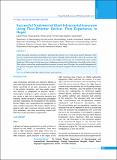Please use this identifier to cite or link to this item:
https://hdl.handle.net/20.500.14356/1329Full metadata record
| DC Field | Value | Language |
|---|---|---|
| dc.contributor.author | Phuyal, Subash | - |
| dc.contributor.author | Agrawal, Pooja | - |
| dc.contributor.author | Lamsal, Ritesh | - |
| dc.contributor.author | Neupane, Nirmal Prasad | - |
| dc.contributor.author | Sedain, Gopal | - |
| dc.date.accessioned | 2023-05-07T08:22:11Z | - |
| dc.date.available | 2023-05-07T08:22:11Z | - |
| dc.date.issued | 2020 | - |
| dc.identifier.citation | PhuyalS., AgrawalP., LamsalR., NeupaneN. P., & SedainG. (2020). Successful Treatment of Giant Intracranial Aneurysm Using Flow-Diverter Device: First Experience in Nepal. Journal of Nepal Health Research Council, 18(3), 563-565. https://doi.org/10.33314/jnhrc.v18i3.2678 | en_US |
| dc.identifier.issn | JNHRC Print ISSN: 1727-5482; Online ISSN: 1999-6217 | - |
| dc.identifier.uri | http://103.69.126.140:8080/handle/20.500.14356/1329 | - |
| dc.description | Case Report | en_US |
| dc.description.abstract | Abstract Giant intracranial aneurysms are defined as aneurysms that measure over 25 mm in the greatest dimension. They are rare vascular lesions that preferentially involve regions with high-velocity blood flow, such as the cavernous and supraclinoid segments of the internal carotid artery, the middle cerebral artery, the vertebrobasilar region, and the basilar apex. The treatment of giant aneurysms is challenging and associated with high rates of morbidity and mortality. Flow-diverter devices have revolutionized their treatment in recent times. We report the successful management of two patients with giant cavernous internal carotid artery aneurysms using flow-diverter devices for the first time in Nepal. Keywords: Endovascular; flow-diverter devices; giant aneurysm | en_US |
| dc.language.iso | en | en_US |
| dc.publisher | Nepal Health Research Council | en_US |
| dc.relation.ispartofseries | Jul-Sep 2020;2678 | - |
| dc.subject | Endovascular | en_US |
| dc.subject | Flow-diverter devices | en_US |
| dc.subject | Giant aneurysm | en_US |
| dc.title | Successful Treatment of Giant Intracranial Aneurysm Using Flow-Diverter Device: First Experience in Nepal | en_US |
| dc.type | Journal Article | en_US |
| local.journal.category | Case Report | - |
| Appears in Collections: | Vol. 18 No. 3 (2020): Vol. 18 No. 3 Issue 48 Jul-Sep 2020 | |
Files in This Item:
| File | Description | Size | Format | |
|---|---|---|---|---|
| 2678-Manuscript-18862-1-10-20201115.pdf | Fulltext Article. | 284.93 kB | Adobe PDF |  View/Open |
Items in DSpace are protected by copyright, with all rights reserved, unless otherwise indicated.
